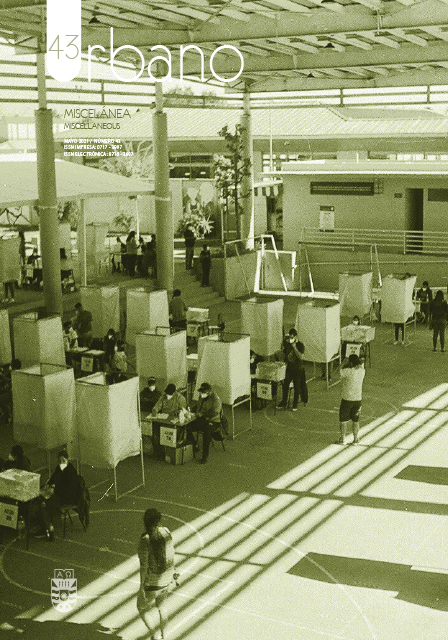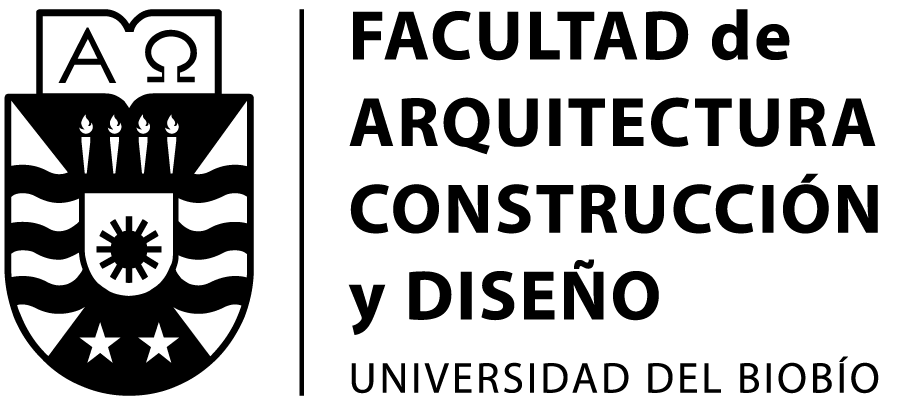Resilient urban design in the foothills of Santiago? Contrast of communal scenarios with seismic risk due to the San Ramón Fault
DOI:
https://doi.org/10.22320/07183607.2021.24.43.09Keywords:
urban design, resilience, seismic risk, San Ramon FaultAbstract
In recent decades, Santiago has seen a substantial increase in urbanized areas along its eastern foothills, where the San Ramón Fault (FSR) is also located. This has become a new geological risk scenario. Using the unquestionable appeal of the natural setting, the panoramic view of the city, and a healthy environment, luxury housing projects have been promoted that coexist with this seismic risk, something that seems to have been disregarded by communal and metropolitan planning instruments. The purpose of this article is to explore the urban design conditions on Santiago’s foothills to face the San Ramon Fault, through a contrast analysis of two specific sectors located within the potential buffer of the San Ramón Fault - the urban districts of Hospital de Carabineros in Las Condes and El Peral in Puente Alto - and the way these articulate with the natural and built environments, including critical infrastructure. Methodologically speaking, a mixed approach is applied through an analysis matrix of urban design elements that includes three areas of action - built, natural and regulatory - to identify critical situations in the areas studied, where the resilient response is either high or low. It is concluded that contrasting urban design experiences under extreme conditions regarding seismic risk is illustrative, both for permeating the operational layers of risk management such as communal and metropolitan regulations, and to consider the foothills in a resilient way, recognizing the San Ramón Fault as a new base criterion of urban design.
Downloads
References
ALLAN, P. Y BRYANT, M. (2011). Resilience as a framework for urbanism and recovery. Journal of Landscape Architecture, 6(2), 34-45. DOI: https://doi.org /10.1080/18626033.2011.9723453
ARMIJO, R., RAULD, R., THIELE, R., VARGAS, G., CAMPOS, J., LACASSIN, R. Y KAUSEL, E. (2010). The West Andean Thrust, the San Ramon Fault, and the seismic hazard for Santiago, Chile. Tectonics, 29, TC2007, 1-34. DOI: https:// doi.org/10.1029/2008TC002427.
CERET (2020). Centro de Estudios del Retail. Recuperado de https://www. ceret.cl/.
Consejo Nacional de Desarrollo Urbano [CNDU] (2020). Sistema de indicadores y Estándares de Calidad de Vida Urbana. Recuperado de https://cndu.gob. cl/download/sistema-de-indicadores-y-estandares-de-calidad-de-vida-urbana/.
Consejo Nacional de Innovación para el Desarrollo [CNID] (2016). Hacia un Chile resiliente frente a desastres: una oportunidad. Estrategia nacional de investigación, desarrollo e innovación para un Chile resiliente frente a desastres de origen natural. Santiago: CREDEN. Recuperado de http://www.cnid.cl/ wp-content/uploads/2016/12/INFORME-DESASTRES-NATURALES.pdf.
CURIHUINCA, M. (2020). Modos de habitar un escenario de riesgo sísmico. El caso de la Falla San Ramón en el piedemonte de Santiago, Chile. Tesis de Magíster en Urbanismo, Universidad de Chile.
Departamento de Estadísticas e Información de Salud [DEIS] (2020). Sistema de Información, Ministerio de Salud. Recuperado de https://deis.minsal.cl/ sistemas-de-informacion/.
EASTON, G., INZULZA, J., PEREZ, S., EJSMENTEWICZ Y JIMENEZ, C. (2018). ¿Urbanización fallada? La Falla San Ramón como nuevo escenario de riesgo sísmico y la sostenibilidad de Santiago, Chile. Revista de Urbanismo, (38), 1-20. Recuperado de https://revistaurbanismo.uchile.cl/index.php/RU/ article/view/48216/62321.
English Partnerships & Housing Corporation [EP&HC] (2007). Urban Design Compendium 1. London: Llewelyn-Davies.
GEORESEARCH. Plataforma de Geointeligencia (2020). Recuperado de https://geo-research.com/inmobiliaria/.
GOPLACEIT. Registro de Ventas de Propiedades GOPLACEIT (2020). Recuperado de https://www.goplaceit.com/cl/
Growth Form Knowledge [GfK] (2019). Estilos de vida de los grupos socioeconómicos de Chile. Recuperado de https://www.anda.cl/wp-content/ uploads/2019/05/GfK_GSE_190502_FINAL.pdf.
Infraestructura de Datos Geoespaciales de Chile [IDE] (2020). Recuperado de http://www.ide.cl/index.php.
Instituto Nacional de Estadísticas [INE] (2017). Síntesis de Resultados. CENSO 2017. Recuperado de http://www.censo2017.cl/descargas/home/sintesis-de-resultados-censo2017.pdf.
Ministerio de Educación [MINEDUC] (2020). Información sobre educación. Recuperado de https://www.mineduc.cl/servicios/informacion-sobre-educacion/
Ministerio de Vivienda y Urbanismo [MINVU] (2014). Hacia una nueva Política Urbana para Chile. Política Nacional de Desarrollo Urbano. Santiago: MINVU. Recuperado de http://cndu.gob.cl/wp-content/uploads/2014/10/L4- Politica- Nacional-Urbana.pdf
MOSER, C., SOU, G. Y STEIN, A. (2011). Climate change and assets, Briefing Paper 2, Global Urban Research Centre. Manchester: University of Manchester.
MOUGHTIN, C. (1999). Urban Design: Street and Square. Oxford: Architectural Press.
Naciones Unidas (2017). Nueva Agenda Urbana. Quito: Secretaría de Hábitat III. Recuperado de https://uploads.habitat3.org/hb3/NUA-Spanish.pdf
Naciones Unidas (2018). Agenda 2030 y los Objetivos de Desarrollo Sostenible Una oportunidad para América Latina y el Caribe. Santiago: Comisión Económica para América Latina y el Caribe [CEPAL].
Oficina Nacional de Emergencia [ONEMI] (2020). Política Nacional para la Reducción del Riesgo de Desastres. Plan Estratégico Nacional 2020-2030. Santiago: ONEMI, Ministerio del Interior y Seguridad Pública.
ONU-HÁBITAT (2018). Urban Resilience Hub. Recuperado de http:// urbanresiliencehub.org/.
RAULD, R. (2011). Deformación cortical y peligro sísmico asociado a la falla San Ramón en el frente cordillerano de
Santiago, Chile Central (33oS). Tesis de Doctorado en Ciencias (Mención Geología). Universidad de Chile, Santiago, Chile.
Secretaría Ministerial Metropolitana de Vivienda y Urbanismo [SEREMI-MINVU] (2012a). Estudio Riesgo y Modificación PRMS Falla San Ramón (ID No640-27- LP10), Informe Etapa 2. Análisis de resultados prospecciones y ensayes. Santiago: SEREMI-MINVU.
Secretaría Ministerial Metropolitana de Vivienda y Urbanismo [SEREMI-MINVU] (2012b). Estudio Riesgo y Modificación PRMS Falla San Ramón (ID No640-27- LP10), Informe Etapa 3. Propuesta de disposiciones de carácter normativo regulatorias. Santiago: SEREMI-MINVU.
Servicio de Impuestos Internos [SII] (2020). Mapa digital de avalúo y contribuciones. Recuperado de https://www4.sii.cl/mapasui/internet/#/ contenido/index.html.
United Nations University [UNU] (2014). WeltRisikoBericht 2014: Risikoraum Stadt. Institute for Environment and Human Security (UNU-EHS). Berlín: Bündnis Entwicklung Hilft.
VARGAS, G., FARIAS, M., CARRETIER, S., TASSARA, A., BAIZE, S. & MELNICK, D. (2011). Coastal uplift and tsunami effects associated to the 2010 M(w)8.8 Maule earthquake in Central Chile. Andean Geology, 38(1), 219-238. Recuperado de http://www.andeangeology.cl/index.php/revista1/article/view/V38n1-a12/ html.
VARGAS, G., KLINGER, Y., ROCKWELL, T., FORMAN, S.L., REBOLLEDO, S., BAIZE, S., LACASSIN, R. Y ARMIJO, R. (2014). Probing large intra-plate earthquakes at the west flank of the Andes. Geology, 42(12), 1083–1086. DOI:10.1130/G35741.1.
Downloads
Published
How to Cite
Issue
Section
License
Copyright (c) 2021 Jorge Inzulza-Contardo, Paulina Gatica-Araya, Gabriel Easton-Vargas, Sonia Pérez-Tello

This work is licensed under a Creative Commons Attribution-ShareAlike 4.0 International License.
The content of articles which are published in each edition of Habitat Sustentable, is the exclusive responsibility of the author(s) and does not necessarily represent the thinking or compromise the opinion of University of the Bio-Bio.
The author(s) conserve their copyright and guarantee to the journal, the right of first publication of their work. This will simultaneously be subject to the Creative Commons Recognition License CC BY-SA, which allows others to share-copy, transform or create new materials from this work for non-commercial purposes, as long as they recognize authorship and the first publication in this journal, and its new creations are under a license with the same terms.![]()























